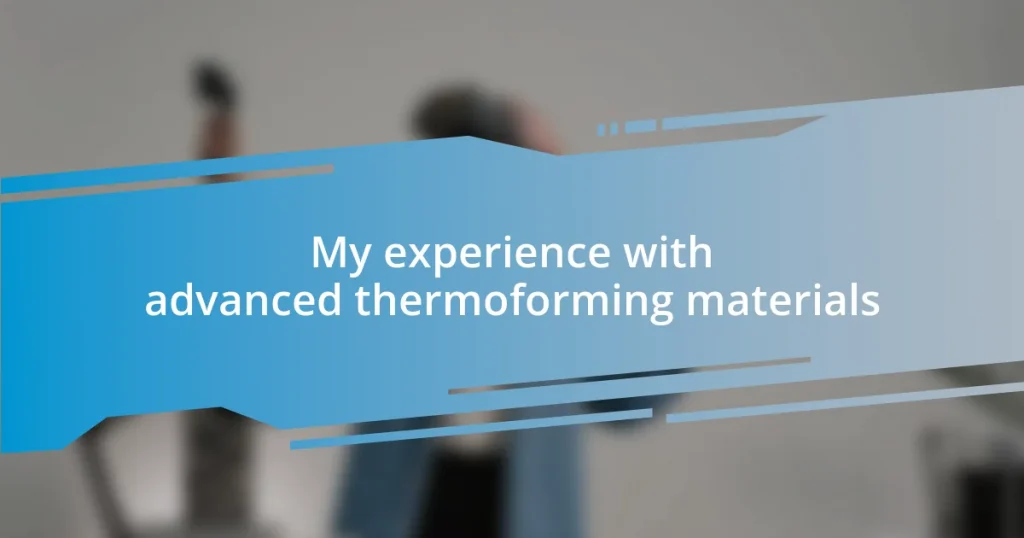Key takeaways:
- Understanding the specific properties of thermoforming materials like ABS, PETG, and polycarbonate is crucial for enhancing product design and functionality.
- Advanced thermoforming techniques offer significant benefits including efficiency, design flexibility, and sustainability, allowing for high-quality production while minimizing environmental impact.
- Future trends in thermoforming point towards greater sustainability, increased automation, and advancements in software technology that enhance design capabilities and efficiency.
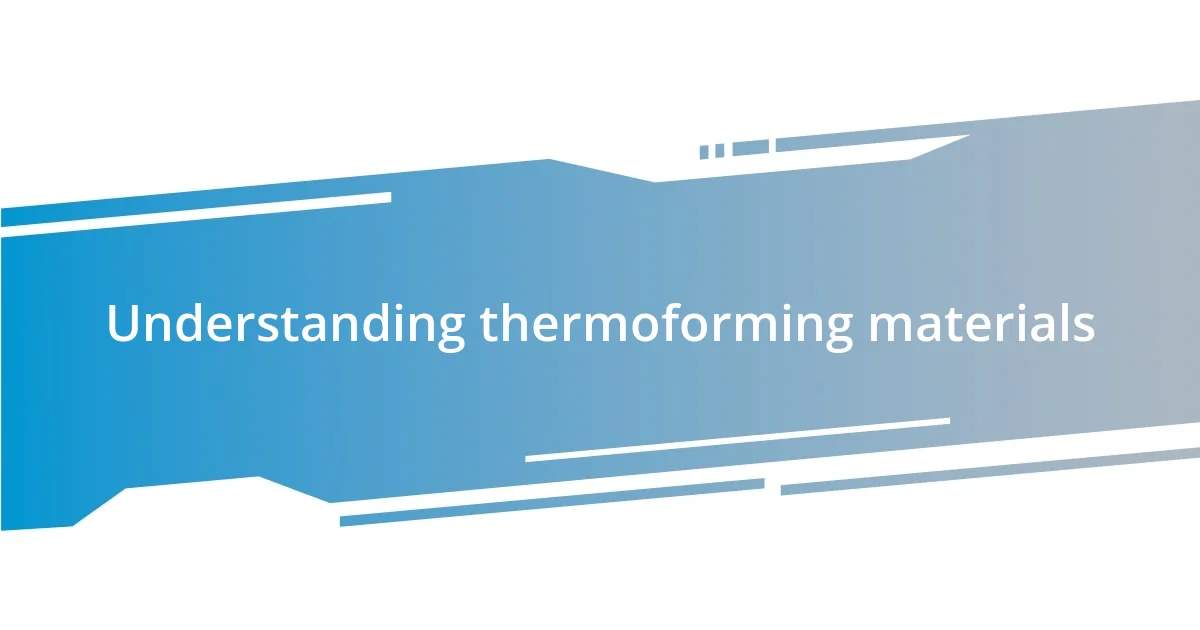
Understanding thermoforming materials
When I first delved into the world of thermoforming materials, I was captivated by their versatility. Thermoforming involves heating plastic sheets until they become pliable, allowing them to be shaped into various forms. Isn’t it fascinating how something so simple can lead to such complex applications in industries like packaging and automotive?
In my experience, understanding the types of materials—like ABS, PETG, and polystyrene—was crucial. Each has distinct properties that make it suitable for different uses. For instance, I remember working on a project where PETG’s clarity and strength were perfect for creating a display case. It’s moments like these that truly highlight how selecting the right material can elevate the design and functionality of a product.
Reflecting on my journey, I often wonder how much innovation stems from mastering these materials. Have you ever considered how a slight change in thickness or composition can drastically alter the outcome of a project? The learning curve may seem steep, but the rewards of understanding these nuances are well worth the effort.
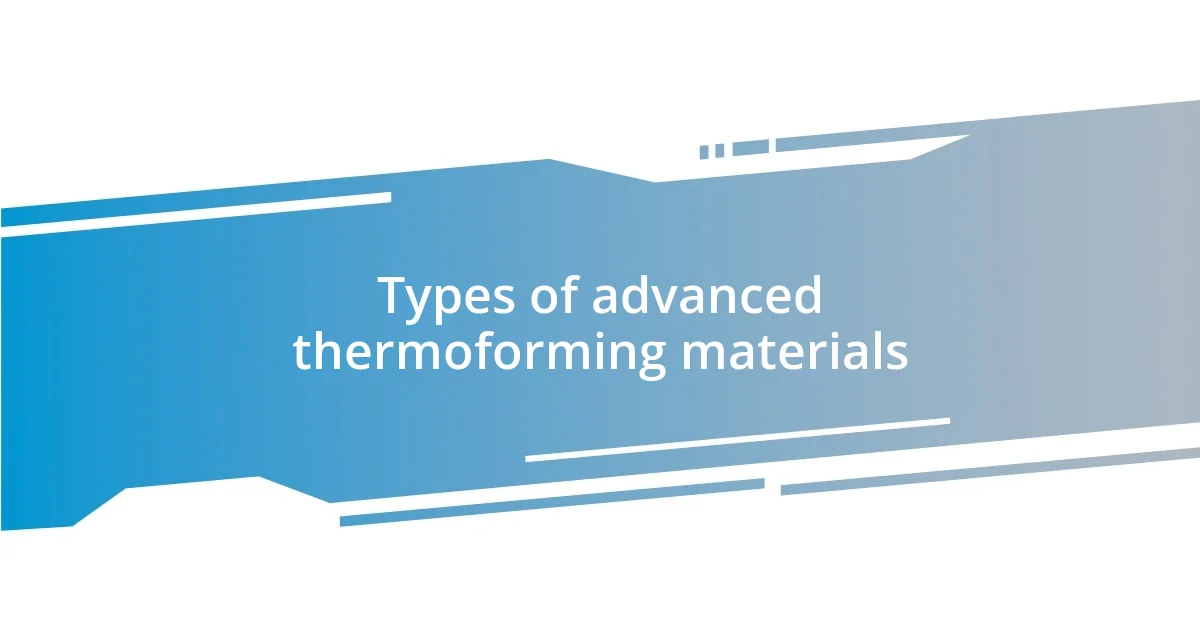
Types of advanced thermoforming materials
Advanced thermoforming materials come in a variety of types, each offering unique properties that cater to specific applications. From my own hands-on experience, I’ve found that selecting the right material can significantly affect not just the appearance but also the durability of the final product. During one project, I was tasked with creating a protective cover. I opted for polycarbonate due to its remarkable impact resistance, which ensured long-term performance. It’s moments like that when the right choice feels like a lightbulb moment.
Here are some common types of advanced thermoforming materials:
- ABS (Acrylonitrile Butadiene Styrene): Known for its toughness and impact resistance, making it ideal for automotive parts.
- PETG (Polyethylene Terephthalate Glycol-Modified): Offers excellent clarity and is widely used for packaging and display items.
- PVC (Polyvinyl Chloride): Affordable and versatile, commonly found in signage and models.
- Polycarbonate: Highly durable with exceptional resistance to heat and impact, often used in safety applications.
- HIPS (High Impact Polystyrene): Lightweight yet sturdy, perfect for creating prototypes and food packaging.
As I explored these materials, I recalled how each project felt like a puzzle, where the various pieces were the different properties of materials. Finding the right fit not only enhances the final product but also fills you with a sense of achievement.
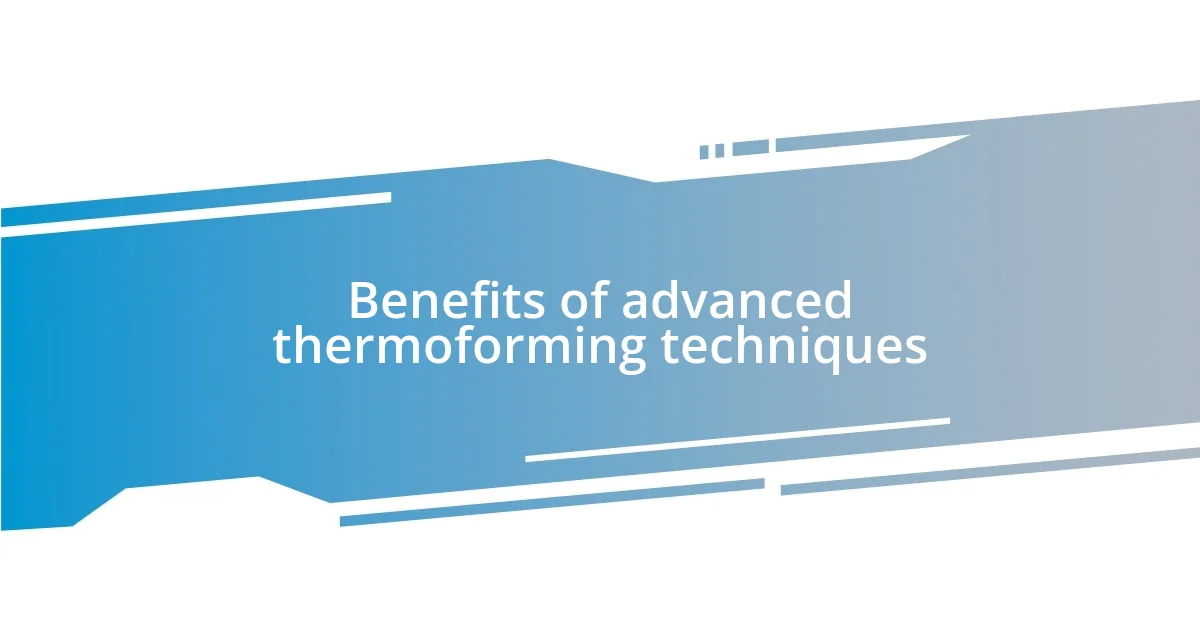
Benefits of advanced thermoforming techniques
The benefits of advanced thermoforming techniques are truly remarkable. One of the most significant advantages I’ve encountered is efficiency. These techniques allow for high production rates while maintaining excellent quality control. I remember a project where we had to ramp up production quickly, and advanced thermoforming saved us both time and resources. It’s exhilarating to see how technology can streamline the process and deliver results faster.
Another key advantage is the design flexibility these techniques provide. You can create complex shapes and detailed features that are simply not possible with traditional methods. I once worked on a project with intricate designs for a medical device. Advanced thermoforming not only met our specifications but also opened up new possibilities for innovation. This kind of flexibility can lead to unique design breakthroughs that truly stand out in a competitive market.
Lastly, the sustainability aspect of advanced thermoforming techniques cannot be overlooked. I’ve been increasingly mindful of the environmental impact of our choices in manufacturing. Many advanced thermoforming materials are recyclable, which makes a tangible difference. Implementing these practices not only contributes to a healthier planet but also resonates with consumers who value sustainability. Finding ways to align my work with eco-friendliness adds a layer of satisfaction to my projects that’s hard to beat.
| Benefit | Description |
|---|---|
| Efficiency | High production rates and quality control, leading to time and resource savings. |
| Design Flexibility | Ability to create complex shapes and detailed features, fostering innovation. |
| Sustainability | Use of recyclable materials, aligning with eco-friendly practices and consumer values. |
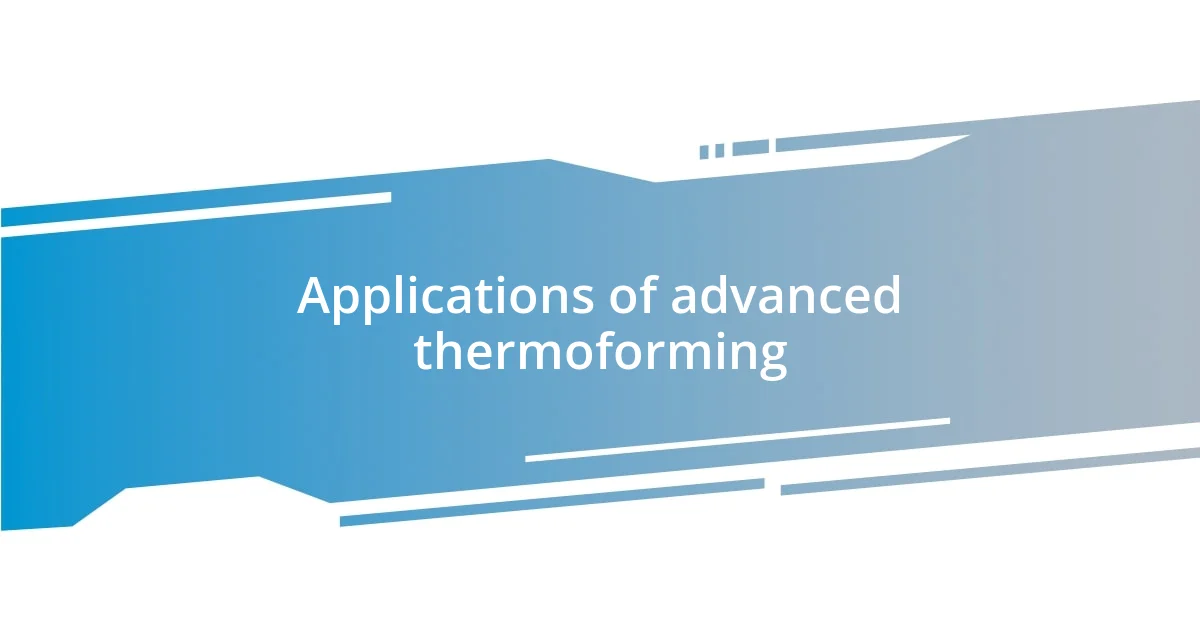
Applications of advanced thermoforming
When I think about the applications of advanced thermoforming, I can’t help but recall one of my favorite projects in the automotive industry. We produced customized interior panels that not only had to fit perfectly but also withstand the wear and tear of daily use. It was incredible to watch how the right thermoformed material, like ABS, transformed our designs into durable components that added both functionality and aesthetics to the vehicles. Isn’t it fascinating how often the smallest details can enhance the overall experience for drivers and passengers alike?
Another striking application I encountered was in the medical field, where precision is paramount. I was part of a team developing a series of intricate trays for surgical instruments, ensuring everything had its place. The flexibility that advanced thermoforming offers allowed us to create tailored solutions that optimized both safety and efficiency during procedures. I often wonder: how does innovation like this carry the potential to save lives simply through thoughtful design?
I also witnessed the use of PETG in packaging solutions that defined a product’s marketability. One time, we designed a striking display for a new cosmetic brand. The clarity of the PETG not only showcased the product beautifully but also elevated the perceived value for consumers. This blend of art and function truly encapsulates why I am passionate about advanced thermoforming. The ability to influence consumer behavior through design is something that I hold dear in my work.
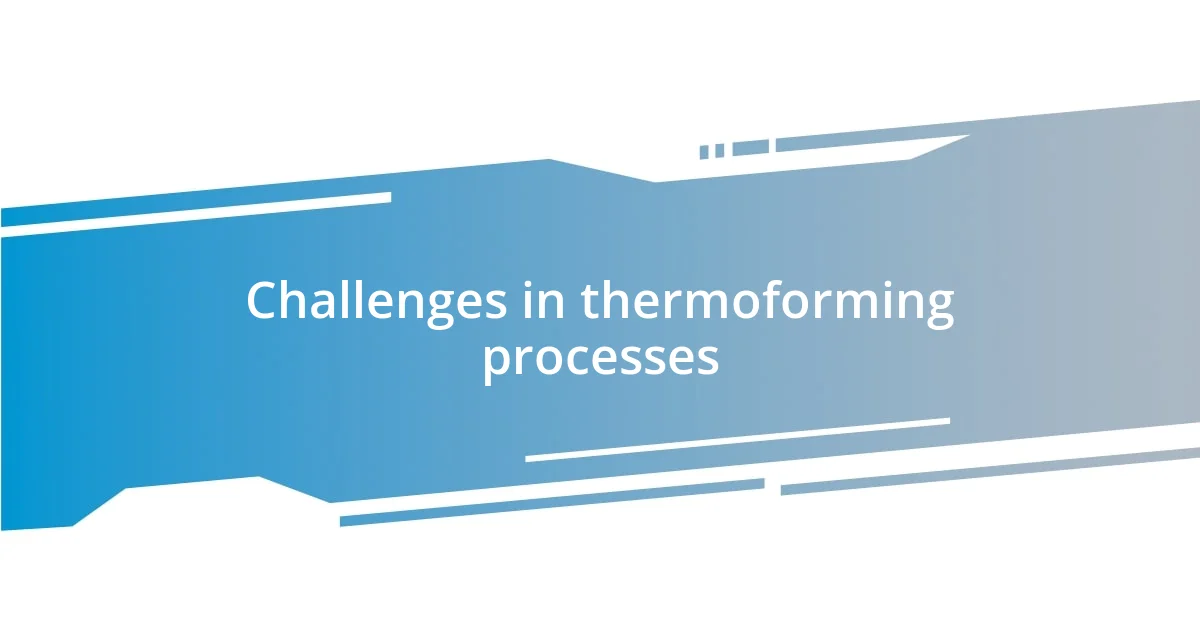
Challenges in thermoforming processes
When it comes to the challenges in thermoforming processes, one major hurdle I’ve faced is material variability. I remember a project where we switched to a new supplier for our ABS sheets, thinking it would enhance our production. However, the unexpected differences in material thickness led to inconsistent forming results. Have you ever encountered a situation where what seemed like a minor change caused significant setbacks? It’s frustrating, but it taught me the importance of thorough quality checks and supplier reliability.
Another challenge I’ve tackled is temperature control during the forming process. I once worked on a job where the thermoforming temperature was slightly off, and it resulted in warping of the final product. The defect wasn’t visible until after we finished the run, which wasted both time and resources. It made me realize how crucial it is to continually monitor and adjust the heating elements. The question of how fine-tuning these parameters can drastically improve outcomes is something we all need to ponder.
Lastly, I’ve grappled with the limitations of tooling when it comes to complex designs. I vividly recall a challenging series of prototypes for a custom consumer product. The initial tooling simply couldn’t accommodate the intricate features we envisioned. It was a tough moment that made me rethink our approach. But, as they say, challenges can spur innovation, and we ended up developing a new mold that not only worked but also pushed the boundaries of what we thought was possible. Isn’t it fascinating how limitations can sometimes lead us to greater creativity?
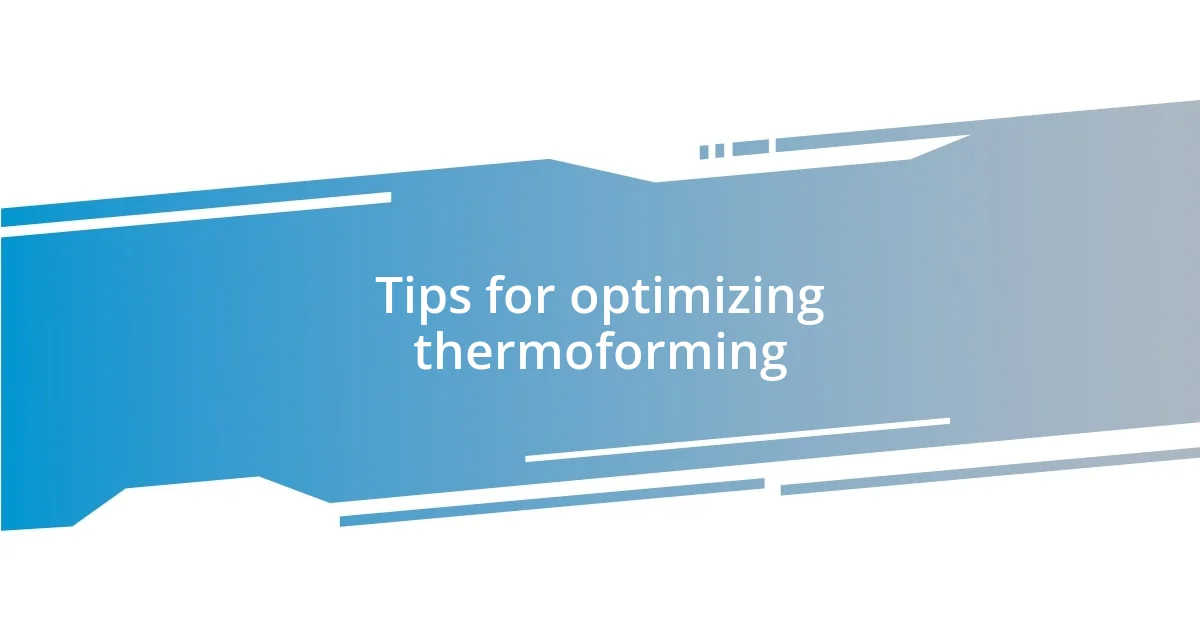
Tips for optimizing thermoforming
When it comes to optimizing thermoforming, I’ve found that the preparation of materials is crucial. For instance, I once spent hours carefully preheating a batch of polycarbonate sheets before forming them. I was amazed by how that small thing enhanced the material’s flexibility and helped achieve a more precise fit. Have you ever considered how seemingly minor adjustments can lead to major improvements in quality? That’s been my experience.
Another tip I can’t emphasize enough is the importance of a well-calibrated heating system. During a project for a medical device case, we dealt with uneven heating that led to thin spots on the final product, which we noticed only during testing. I’ve learned to invest time in monitoring and adjusting temperatures meticulously; it’s a game-changer! Would you agree that the right temperature can make or break the final outcome?
Lastly, don’t underestimate the power of collaboration during the design phase. I recall working closely with engineers and designers on a packaging project. Their insights helped us optimize the geometry of the mold, which ultimately improved the efficiency of the production process. It became clear to me how dialogue between disciplines can unlock new ideas. What’s been your experience collaborating with others to overcome challenges in thermoforming? I believe that sharing perspectives is often the key to innovative solutions.
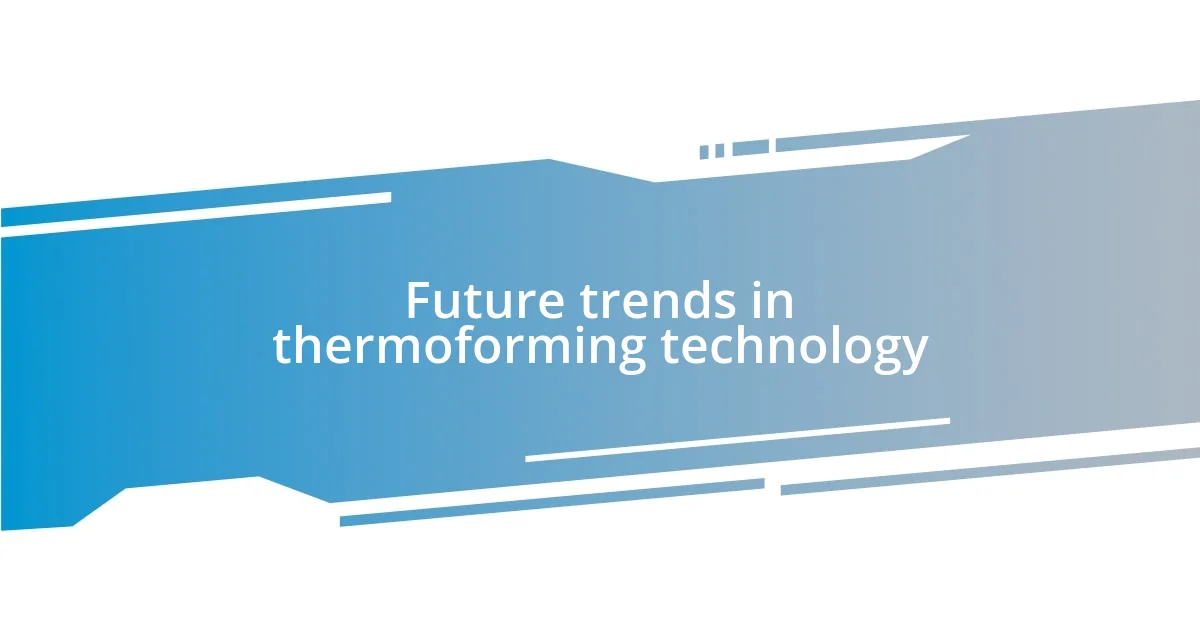
Future trends in thermoforming technology
As I look ahead at future trends in thermoforming technology, I can’t help but feel excited about the increasing role of sustainability. For instance, I recall a recent project where we focused on incorporating recycled materials into our thermoformed products. It not only reduced our environmental footprint but also opened up discussions about sourcing and using more eco-friendly options. Have you ever considered how turning to resource-conscious materials could redefine your own production lines?
Another area I’m keen on is automation. I remember being part of a factory tour where I witnessed a fully automated thermoforming setup in action. The precision and speed were truly impressive, allowing for high-volume production with minimal human intervention. I often think about how this shift towards automated systems can alleviate many of the labor-intensive challenges we’ve faced in the past. Isn’t it amazing to consider how automation could elevate our industry standards?
Finally, advancements in software technology are paving the way for enhanced design capabilities in thermoforming. I had the chance to use a cutting-edge simulation software during a recent design sprint, which allowed us to visualize and iterate on our molds before they were even manufactured. It struck me how vital these tools are in reducing error margins and fostering creativity during the design process. Have you explored how such technologies can enhance the developmental phases of your projects? As I see it, embracing these innovations can indeed lead to a new era of efficiency and creativity in thermoforming.











